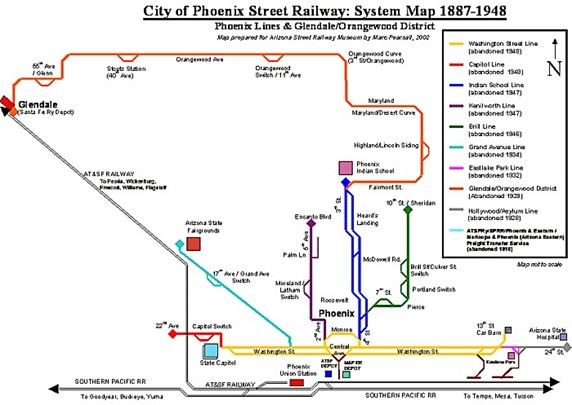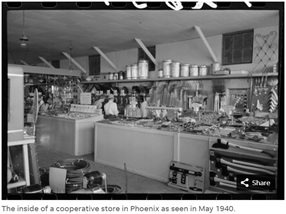By Becky Santiago
In 2022, Valley Metro opened a 3-mile streetcar system in Tempe. Streetcar, light rail…what’s the difference? Well, streetcars are fairly similar to light rail, but the vehicles are smaller and the routes typically serve a more local market compared to the commuters using light rail. And while the streetcar is the Valley’s first modern streetcar, you may be surprised to learn that the region actually had quite an extensive streetcar network back in the day. In fact, as can be seen below, the streetcar system existed in many of the same corridors that Valley Metro’s light rail operates, and then some! It even went out to Grand Avenue and 55th Ave, served the AZ Fairgrounds, and as you’ll see, it also ran right up Coronado’s 10th St!

The Phoenix Street Railway system was founded by Moses Sherman and M.E. Collins in 1887. For the first six years the streetcar vehicles were pulled by mules until electric cars took over in 1893. Its main east/west line served the Capitol on Washington St, and the core north/south line operated from downtown to Phoenix Indian School. Like today’s light rail system, most of the streetcars operated in the middle of the streets. The system was purchased by the City of Phoenix in 1925, which improved the network by adding newer vehicles and providing better frequency. The 10th St streetcar line was a branch of the main system (blue and yellow lines) and ran east/west on Pierce St (just north of Fillmore St), and then turned north on 10th St where it terminated at 10th St and Sheridan St.

As transportation networks typically do, the system helped shape development in the Valley. For example, both the Willo Historic District and our very own Coronado Historic District began as streetcar suburbs. But ridership started declining in the 1920s as the popularity of automobiles grew. The system took an even greater loss when the Great Depression hit and service had to be reduced. Ultimately, a fire near 13th St and Van Buren in 1947 destroyed part of a line and the city elected to replace the network with buses instead of rebuilding it.

The abandonment of the system further encouraged personal automobile use, whose complementary highway system was almost entirely funded by federal dollars, sparking the development of Phoenix’s massive freeway system (as it did in most major U.S. cities). Perhaps even better than streetcars, we know the impact highways had on development, to both existing neighborhoods and those yet to be built. Yet as cities face growing pressure to address climate change challenges, growing congestion problems, and the need to provide equitable access to education and economic opportunities (just to list a few), we see them returning to their roots, revitalizing or reconstructing mass transit systems as a primary tool to achieve multiple goals. We see it happening here in the Valley too.

So if you’ve ever thought that the buildings on the corner of 10th St at Sheridan St or Oak St look a little more like old bars or groceries stores instead of homes, that’s because that’s what those used to be! Or at least something a bit more commercial. And while I haven’t been able to confirm, I like to imagine the building on northwest corner of Oak St and 10th used to be a cooperative store like the one below, almost like our beloved Sunshine Market.
Article written by Becky Santiago for the 2021 Winter Dispatch. Images and historical information from: https://www.roguecolumnist.com/rogue_columnist/2017/02/phoenix-101-streetcars.html
